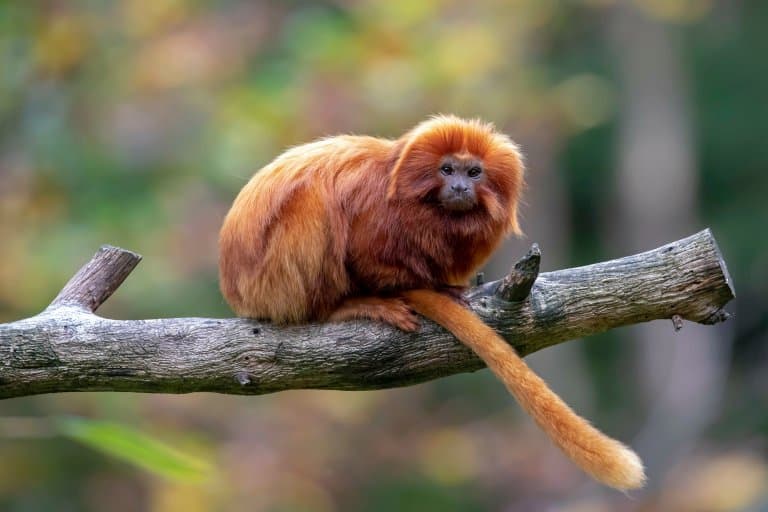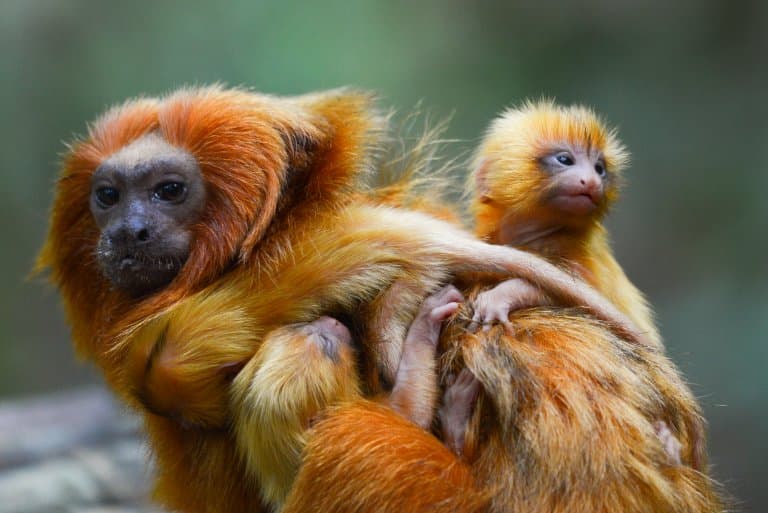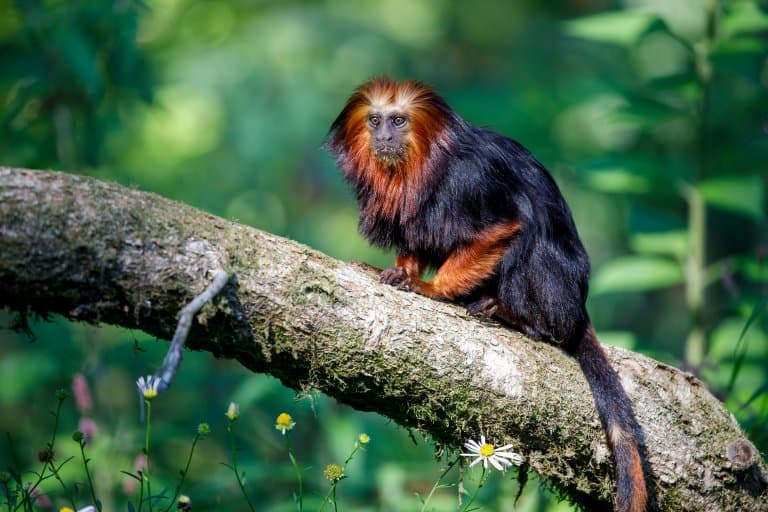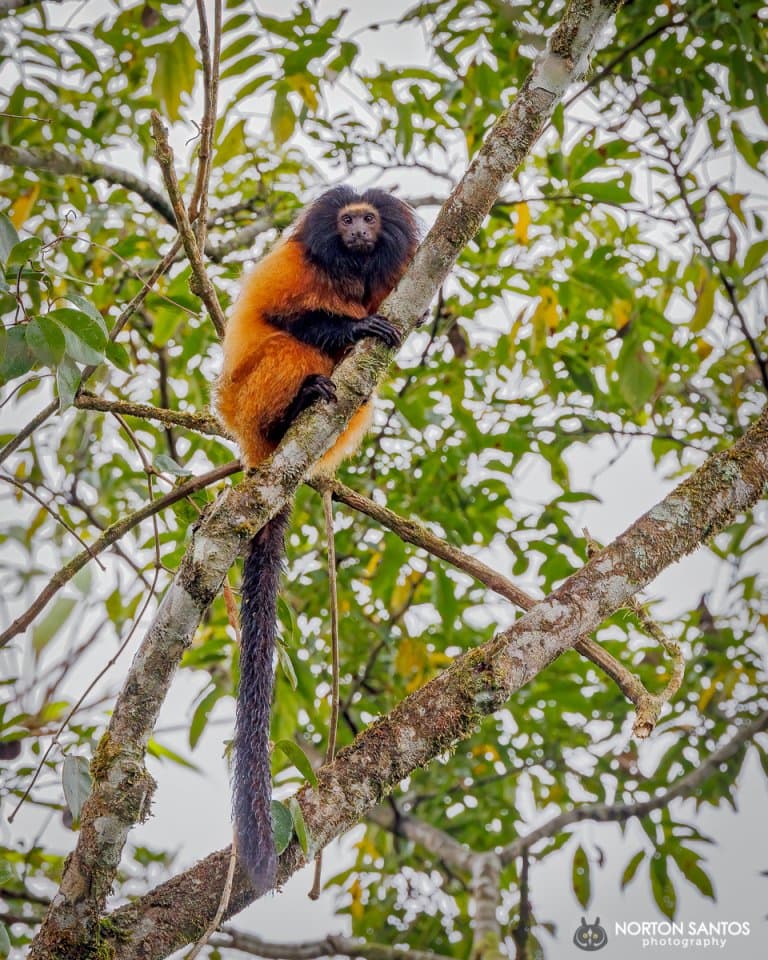Lion Tamarin Profile
In the heavily threatened Brazilian rainforest, there’s a small champion with a big mane that’s captivated the attention of conservationists and animal fans all over the world.
Its charisma has all but ensured its survival, as long as the forest remains intact. Lion tamarins represent a small genus of miniature monkeys with a big presence in conservation.

Lion Tamarin Facts Overview
| Habitat: | Rainforests |
| Location: | Eastern Brazil |
| Lifespan: | Up to 20 years in captivity, around 12 in the wild. |
| Size: | Around 60cm long (2ft), including tail |
| Weight: | Up to around 1kg (35oz) |
| Colour: | Black, brown, or gold with a vivid golden mane |
| Diet: | Omnivorous: invertebrates, leaves, seeds |
| Predators: | Snakes, predatory birds, cats, humans |
| Top Speed: | Fast |
| No. of Species: | 4 |
| Conservation Status: | All Endangered (IUCN) |
There are four species of this very small, fluffy monkey, all of which live in family groups in the eastern rainforests of Brazil in the trees.
Lion tamarins are routinely seen practicing social grooming. In addition to keeping their coats healthy, these grooming rituals create strong bonds between group members. They spend their time jumping through the trees in search of insects to eat, as well as the occassional lizard, snake and fruit.
Sadly, all of them are endangered and declining in numbers.
This is primarily a result of relentless deforestation that not only reduces their habitat but breaks it into islands from which isolated populations can’t interact with one another.
But the good news is that most have a very active and well-supported captive population, and they’re very popular with the general public.
They’re also resilient little monkeys, and there have been numerous conservation successes in their name already.
Interesting Lion Tamarin Facts
1. They’re agile
While lots of monkeys jump crashingly into the lower branches from up high, lion tamarins appear to be particularly suited to arboreal life and can run, climb and leap with particular agility.
They have clawed feet that allow them to scale trunks of trees in a way that more resembles that of a squirrel, something which is compounded by their small size as dwarf monkeys.
Being tiny has its advantages when it comes to rapid movement through the canopy.
2. They’re in a bit of trouble in the wild
The IUCN lists all four species in this genus as endangered, and of them, the black-faced lion tamarin is the worst affected.
The total population of this poor animal may be as low as 250 mature individuals, with around seven or eight in each square kilometre, and the numbers are decreasing.
The golden-headed lion tamarin is thought to make up around 400-450 mature individuals, and the flagship species, the golden tamarin, is thought to consist of 1,400 mature individuals.
As they rely on mature forest ecosystems, there’s no room for tolerance of habitat destruction in the species, which is why they’re so badly in danger from deforestation.
It’s estimated that potential habitats are available for up to 1,500 black-faced golden tamarins, which does bode well for their conservation if they can get the support they need. The main issue at hand is habitat fragmentation, in which isolated groups of monkeys aren’t able to find one another to breed. 1
3. They’re part of their own conservation story
Breeding programs are one of the keys to successfully saving the lion tamarins, and this means housing as many as possible inside responsible zoos. But one of the perks of keeping them captive is being able to spread awareness of their plight, and with a monkey this smart, they can do that themselves.
At the Smithsonian National Zoo, a troop of lion tamarins were once seen taking part in monkey theatre, providing a show for visitors that re-enacts their plight. Shows would incorporate a human villain, walking into their set with a chainsaw; who was quickly dispatched by the monkeys.
Since then, new tamarins have been born and raised in the zoo, and in 2019, the first set of twins for 16 years arrived to a golden-headed lion tamarin mother. In the wild, more than two-thirds of these yearly births would be twins. 2
4. They’re good parents
Females give birth to twins after a gestation of 130 to 135 days, and at least within Golden Lion Tamarin family groups, both parents actively participate in raising their yearly twins.
The mother nurses the young every two to three hours, providing essential nourishment, while the father plays a vital role by carrying the babies on his back, bouncing them on his knee, and other dad stuff.
This makes their reintroduction and repopulation in the wild a high likelihood if all other factors causing them issues could be fixed.

5. This has proven to be valuable already
While the Golden lion tamarin was almost extinct in the wild by 1960, a series of captive breeding programs and reintroductions, combined with translocation efforts has managed to bring the population up significantly.
In the ‘80s, around 30 zoos worked to reintroduce 146 of the monkeys. In 1994, isolated fragments were reunited with other populations in protected areas. 3
6. Peeps and whines
Lion tamarins make a range of cute little noises to match their cute little faces. Not only do these calls convey information to one another, but they can also help conservationists identify details about the populations as well.
When trying to count the monkeys in a forest (or any other animal, for that matter) it’s difficult to see anything at all. In the case of lion tamarins, these vocalisations can be used to great effect.
By playing pre-recorded calls, researchers from the Golden Lion Tamarin Association in Brazil were able to elicit responses from individuals in the canopy, allowing them to be counted.
Peeps are friendly calls, and whines are generally nervous ones. They also cluck, to locate one another and juveniles will make rasps or screeches while playing.
All of these sounds are significant to the social bonding of the groups and play an important role in keeping the family close, emotionally and physically. 4 5

7. Golden Tamarins are the flagship species
It’s a sad fact of life that ugly or smelly animals get the least attention, despite being just as worthy of conservation as anybody else.
When faced with an issue of habitat destruction, it’s useful to have a charismatic individual to lead the charge and carry the protection efforts.
Fortunately, the Golden lion tamarin is about as charismatic as it gets, and one of the reasons that lion tamarins are receiving so much conservation attention is essentially down to the ‘pretty privilege’ of these animals.
The habitat of the Golden lion tamarin is home to a record number of less appealing endemic species. This rarity is so important to the ecosystem and consequently so vulnerable to its destruction.
Like C.S. Lewis’s Aslan, this maned champion has to come to the rescue of a unique and diverse forest ecosystem.
8. Vaccines have been used to protect select populations
Some populations of golden lion tamarin have been vaccinated against certain viruses. These vaccination programs are meant to protect not only the tamarin species, but humans that live locally as well. 6
9. Some species are still traded as pets
Despite it being an illegal practice, some tamarins are still hunted and sold as pets around the world. Continuous conservation efforts are in place to reduce these exchanges.

10. They have many threats from above and below
Due to their small size, they have plenty of predators from both mammals on the ground, animals in the trees and above in the air.
Snakes, birds of prey, wild dogs, and cats are all known to prey on lion tamarins!
Lion Tamarin Fact-File Summary
Scientific Classification
| Kingdom: | Animalia |
| Phylum: | Chordata |
| Class: | Mammalia |
| Order: | Primates |
| Family: | Callitrichidae |
| Genus: | Leontopithecus |
| Species Names: | Golden lion tamarin (Leontopithecus rosalia) Golden-headed lion tamarin (Leontopithecus chrysomelas) Black lion tamarin or golden-rumped lion tamarin (Leontopithecus chrysopygus) Superagui lion tamarin or black-faced lion tamarin (Leontopithecus caissara) |
Fact Sources & References
- “Black-faced Lion Tamarin”, IUCN.
- Lorna Williams (1988), “ZOO’S TAMARINS TEACH A LIVELY GOLDEN RULE”, Washington Post.
- M. C. M. Kierulff (2018), “The Golden lion tamarin Leontopithecus rosalia: a conservation success story”, Zoological Society of London.
- TOMOKO MAEDA (1986), “Locale-specific Vocal Behaviour of the Tamarin (Saguinus 1. labiatus)”, Sci Hub.
- “GOLDEN LION TAMARIN Leontopithecus rosalia”, New England Primate Conservancy.
- “Golden Lion Tamarins“, Save the Lion Tamarin.
